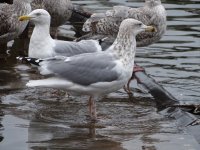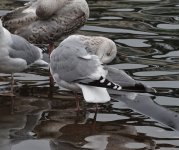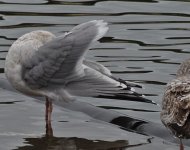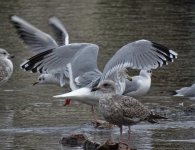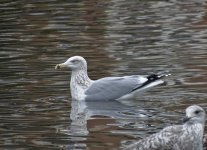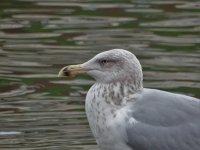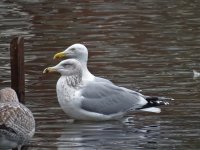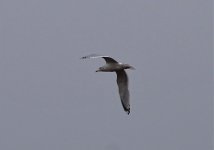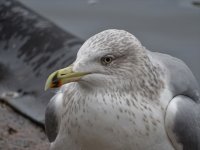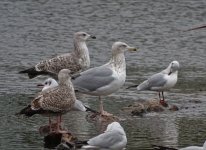Dean Nicholson
Cloacal Protuberant.
Can anybody tell me why this isn't a smiths?....
Just about everything about it seems good to me with the exception maybe of the black of p9 reaching the G Covs - but even that can be found on photos of birds from across the Atlantic in a relatively brief search. I was also slightly worried about the apparent all white tip to p10 but if you look closely at the outer webs you can just make out a small notch of a sub-terminal band - and once again, it's not too difficult to find shots on the internet of smiths with all white p10 tips.
*P10 tongue is long and blunt/steep ended (over half the feather length with the black medial band being shorter than the mirror/tip).
*p9 mirror confined to inner web with long tongue
*p8 shape perfect for smiths with prominent white tongue tip and hint of small bayonet on outerweb
*p7 & p6 both with 'bayenets'
*p5 broken in middle but still with a hint of a 'w'... this pattern also not difficult to find on shots of smiths from America
Despite the dark markings in the bill the plumage and whiteish iris suggests the bird is a full adult (no dark marks in any covs or tail), the bill is also very pale with minimal red on gonys. The mantle tone was pale grey, same as the argenteus Herrings and very close to Black-headed Gulls. Dense head and neck streaking, thickest on hind neck and reaching well down onto breast - this pattern was matched on a few other birds but all these all proved to be sub-ads with varying dark marks in the prim coverts/tail. The legs could appear very pink at times but this hasn't translated so well in the shots.
It was a big, hulking bully of a bird which was very dominant when bread was thrown and regularly pecked out at and chased off any birds that strayed into its personal space. Despite the good numbers of birds present it was never too difficult to pick up such was its distinctiveness in both looks and behaviour - a very impressive bird.
It was at Goodrington Boating Lake, Paignton on 28th Dec.
I've shared the shots with my usual gullerati contacts and they've all been impressed and suggested a wider audience so here it is.... Comments welcome and Happy New Year to all...
Cheers
Dean
PS (I considered southern argentatus/Baltic argentatus and even Glauc genes but just think smiths is a better fit over all, but obviously there is bewildering variations in all of these, I think argentatus Herrings are genuinely scarce in SW England - certainly when I've been looking in recent winters anyway....)
Just about everything about it seems good to me with the exception maybe of the black of p9 reaching the G Covs - but even that can be found on photos of birds from across the Atlantic in a relatively brief search. I was also slightly worried about the apparent all white tip to p10 but if you look closely at the outer webs you can just make out a small notch of a sub-terminal band - and once again, it's not too difficult to find shots on the internet of smiths with all white p10 tips.
*P10 tongue is long and blunt/steep ended (over half the feather length with the black medial band being shorter than the mirror/tip).
*p9 mirror confined to inner web with long tongue
*p8 shape perfect for smiths with prominent white tongue tip and hint of small bayonet on outerweb
*p7 & p6 both with 'bayenets'
*p5 broken in middle but still with a hint of a 'w'... this pattern also not difficult to find on shots of smiths from America
Despite the dark markings in the bill the plumage and whiteish iris suggests the bird is a full adult (no dark marks in any covs or tail), the bill is also very pale with minimal red on gonys. The mantle tone was pale grey, same as the argenteus Herrings and very close to Black-headed Gulls. Dense head and neck streaking, thickest on hind neck and reaching well down onto breast - this pattern was matched on a few other birds but all these all proved to be sub-ads with varying dark marks in the prim coverts/tail. The legs could appear very pink at times but this hasn't translated so well in the shots.
It was a big, hulking bully of a bird which was very dominant when bread was thrown and regularly pecked out at and chased off any birds that strayed into its personal space. Despite the good numbers of birds present it was never too difficult to pick up such was its distinctiveness in both looks and behaviour - a very impressive bird.
It was at Goodrington Boating Lake, Paignton on 28th Dec.
I've shared the shots with my usual gullerati contacts and they've all been impressed and suggested a wider audience so here it is.... Comments welcome and Happy New Year to all...
Cheers
Dean
PS (I considered southern argentatus/Baltic argentatus and even Glauc genes but just think smiths is a better fit over all, but obviously there is bewildering variations in all of these, I think argentatus Herrings are genuinely scarce in SW England - certainly when I've been looking in recent winters anyway....)




